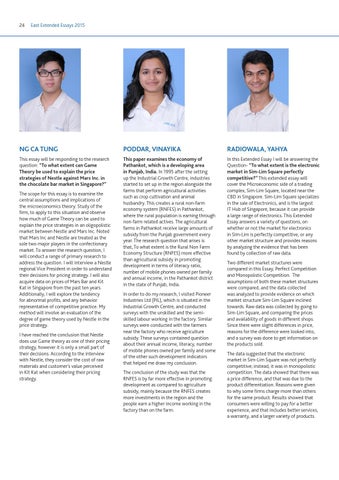24 East Extended Essays 2015
NG CA TUNG
PODDAR, VINAYIKA
RADIOWALA, YAHYA
This essay will be responding to the research question: “To what extent can Game Theory be used to explain the price strategies of Nestle against Mars Inc. in the chocolate bar market in Singapore?”
This paper examines the economy of Pathankot, which is a developing area in Punjab, India. In 1995 after the setting up the Industrial Growth Centre, industries started to set up in the region alongside the farms that perform agricultural activities such as crop cultivation and animal husbandry. This creates a rural non-farm economy system (RNFES) in Pathankot, where the rural population is earning through non-farm related actives. The agricultural farms in Pathankot receive large amounts of subsidy from the Punjab government every year. The research question that arises is that, To what extent is the Rural Non Farm Economy Structure (RNFES) more effective than agricultural subsidy in promoting development in terms of literacy ratio, number of mobile phones owned per family and annual income, in the Pathankot district in the state of Punjab, India.
In this Extended Essay I will be answering the Question- “To what extent is the electronic market in Sim-Lim Square perfectly competitive?” This extended essay will cover the Microeconomic side of a trading complex, Sim-Lim Square, located near the CBD in Singapore. Sim-Lim Square specializes in the sale of Electronics, and is the largest IT Hub of Singapore, because it can provide a large range of electronics. This Extended Essay answers a variety of questions, on whether or not the market for electronics in Sim-Lim is perfectly competitive, or any other market structure and provides reasons by analyzing the evidence that has been found by collection of raw data.
The scope for this essay is to examine the central assumptions and implications of the microeconomics theory: Study of the firm, to apply to this situation and observe how much of Game Theory can be used to explain the price strategies in an oligopolistic market between Nestle and Mars Inc. Noted that Mars Inc and Nestle are treated as the sole two major players in the confectionary market. To answer the research question, I will conduct a range of primary research to address the question. I will interview a Nestle regional Vice President in order to understand their decisions for pricing strategy. I will also acquire data on prices of Mars Bar and Kit Kat in Singapore from the past ten years. Additionally, I will explore the tendency for abnormal profits, and any behavior representative of competitive practice. My method will involve an evaluation of the degree of game theory used by Nestle in the price strategy. I have reached the conclusion that Nestle does use Game theory as one of their pricing strategy, however it is only a small part of their decisions. According to the interview with Nestle, they consider the cost of raw materials and customer’s value perceived in Kit Kat when considering their pricing strategy.
In order to do my research, I visited Pioneer Industries Ltd (PIL), which is situated in the Industrial Growth Centre, and conducted surveys with the unskilled and the semiskilled labour working in the factory. Similar surveys were conducted with the farmers near the factory who receive agriculture subsidy. These surveys contained question about their annual income, literacy, number of mobile phones owned per family and some of the other such development indicators that helped me draw my conclusion. The conclusion of the study was that the RNFES is by far more effective in promoting development as compared to agriculture subsidy, mainly because the RNFES creates more investments in the region and the people earn a higher income working in the factory than on the farm.
Two different market structures were compared in this Essay, Perfect Competition and Monopolistic Competition. The assumptions of both these market structures were compared, and the data collected was analyzed to provide evidence on which market structure Sim-Lim Square inclined towards. Raw data was collected by going to Sim-Lim Square, and comparing the prices and availability of goods in different shops. Since there were slight differences in price, reasons for the difference were looked into, and a survey was done to get information on the products sold. The data suggested that the electronic market in Sim-Lim Square was not perfectly competitive; instead, it was in monopolistic competition. The data showed that there was a price difference, and that was due to the product differentiation. Reasons were given to why some firms charge more than others for the same product. Results showed that consumers were willing to pay for a better experience, and that includes better services, a warranty, and a larger variety of products.
